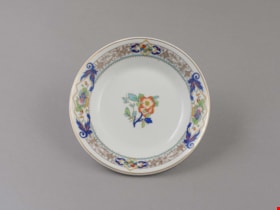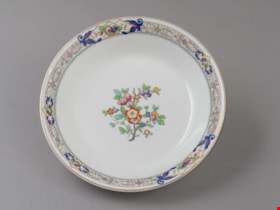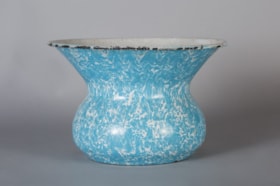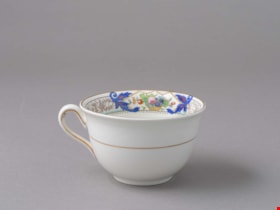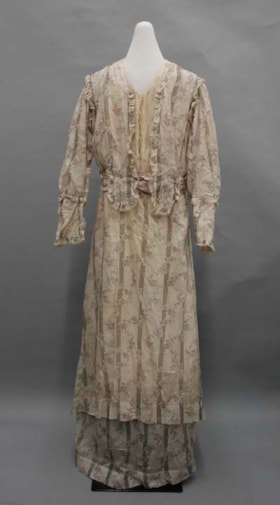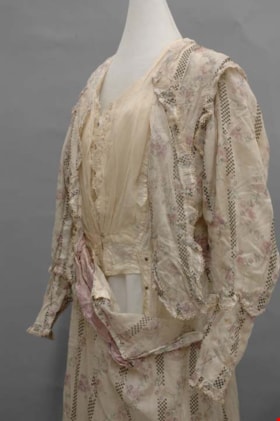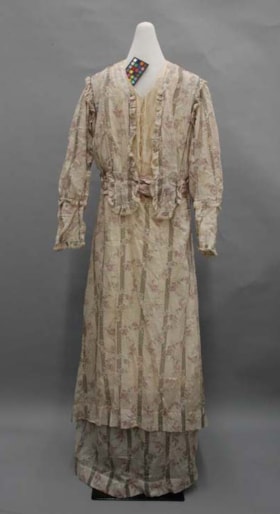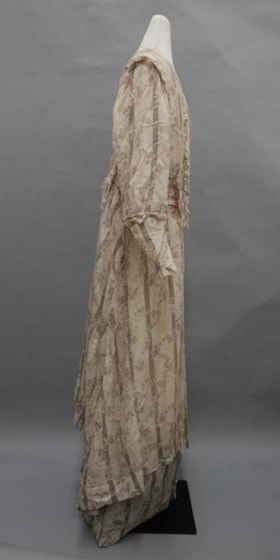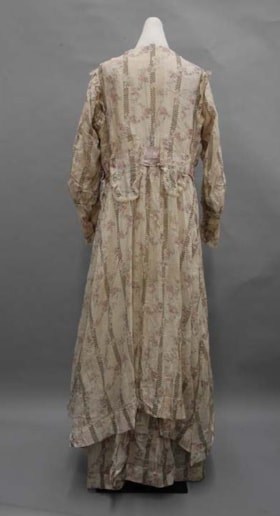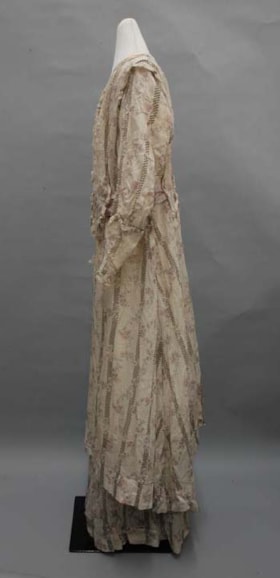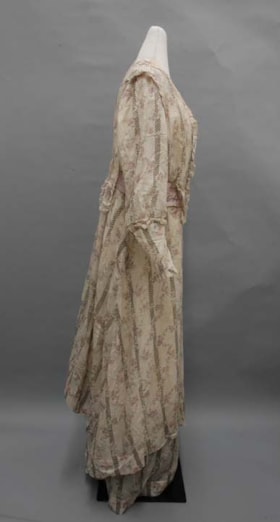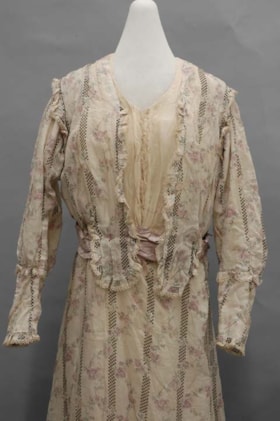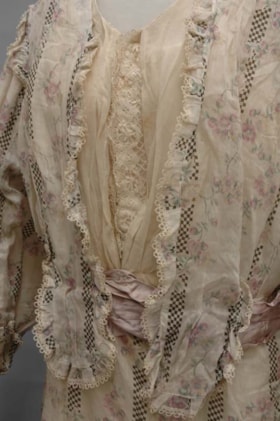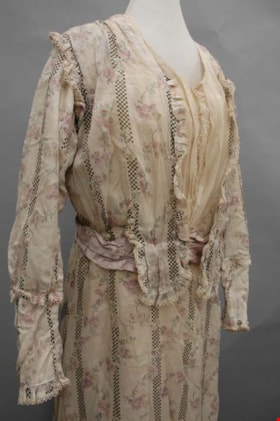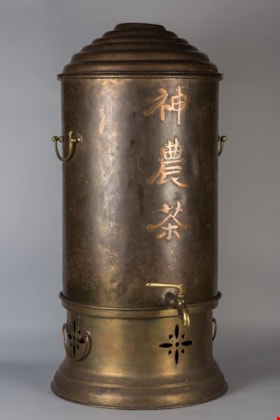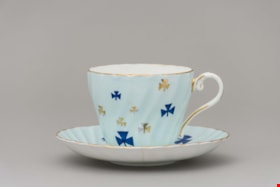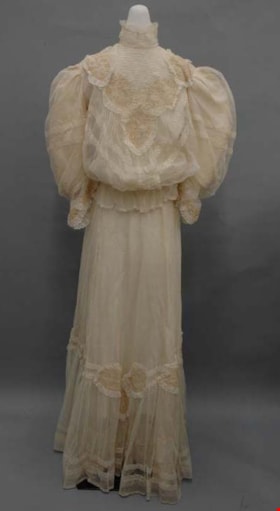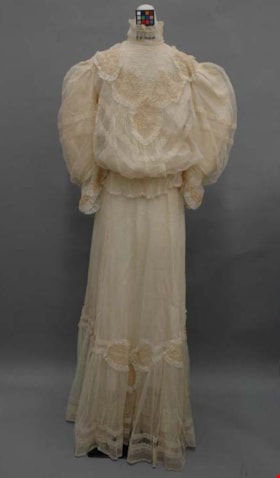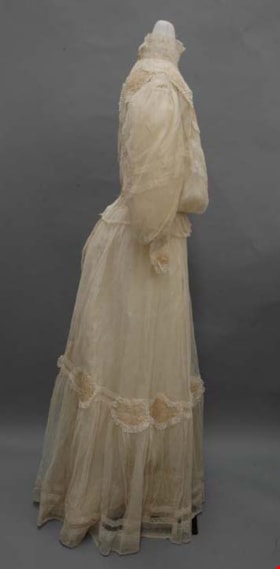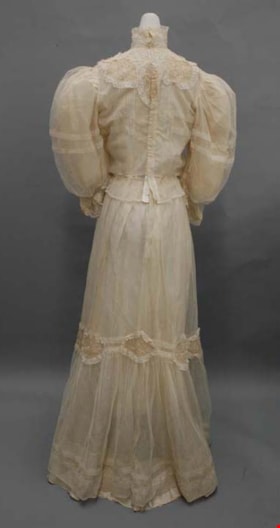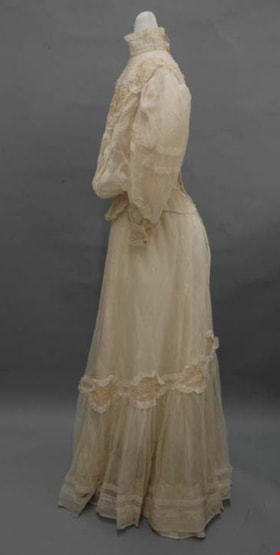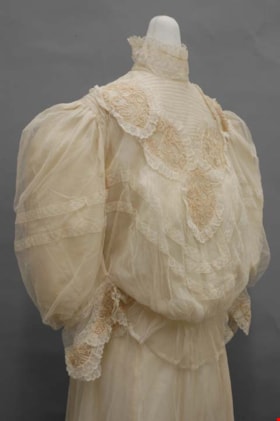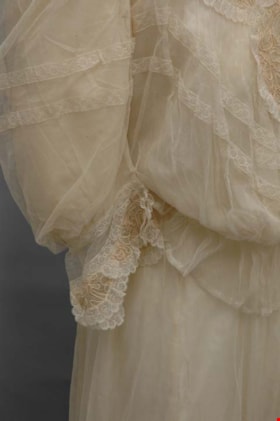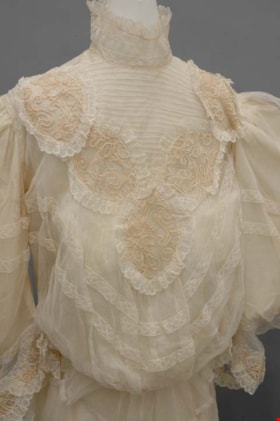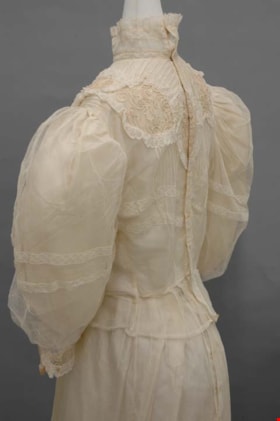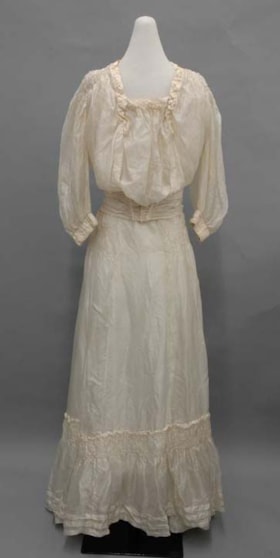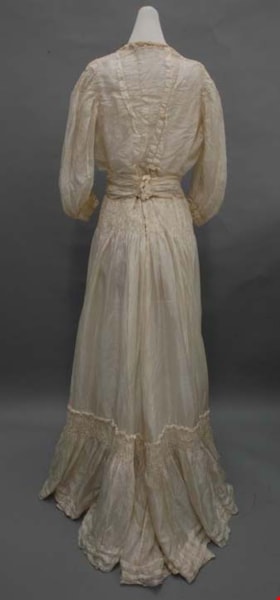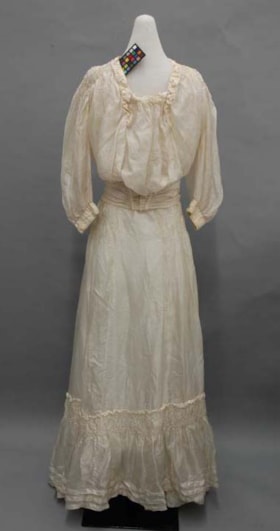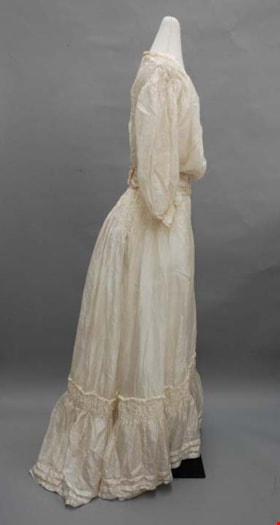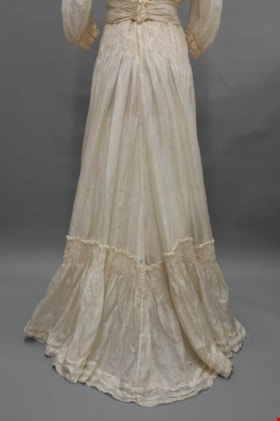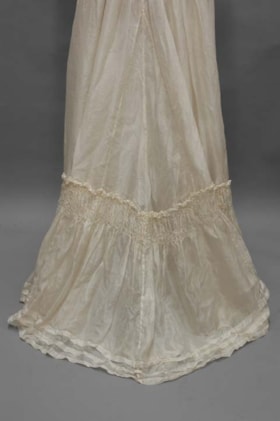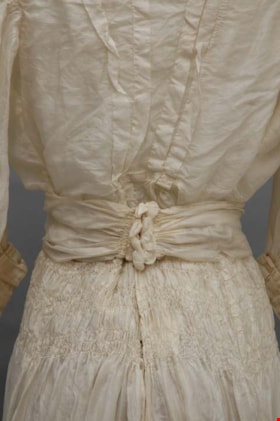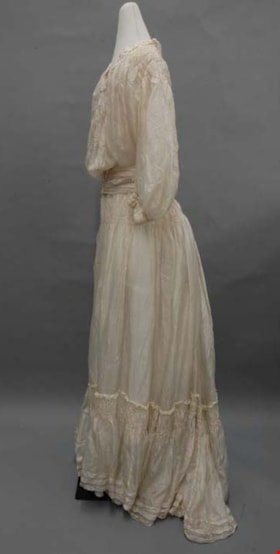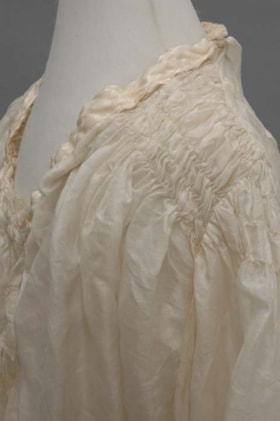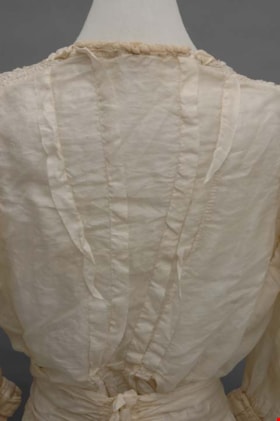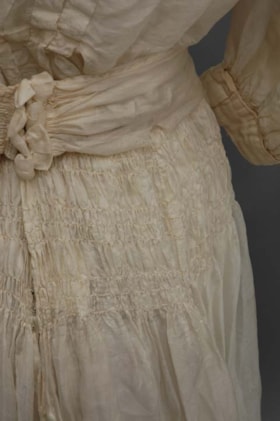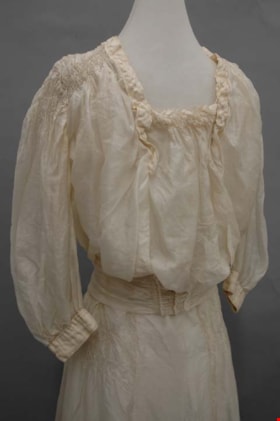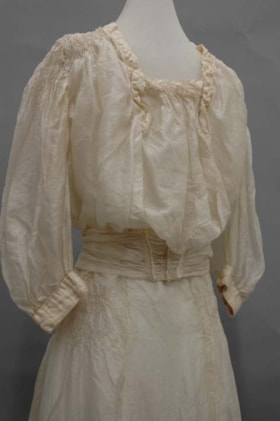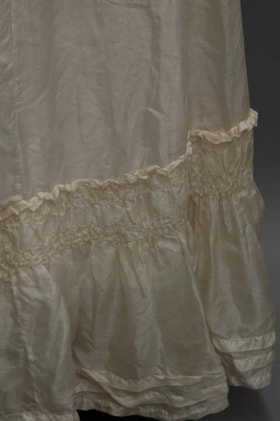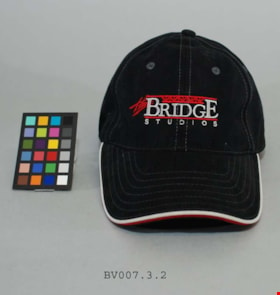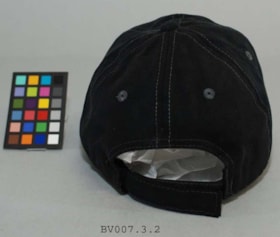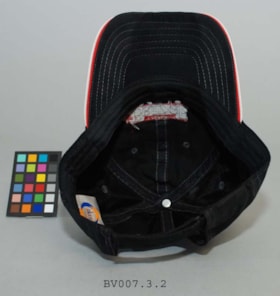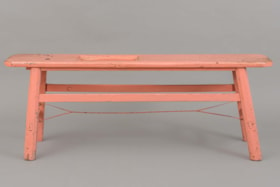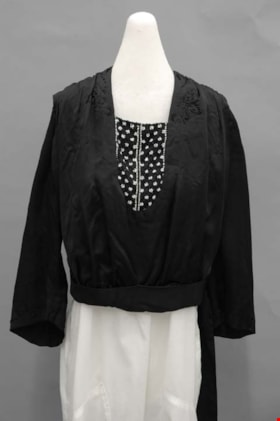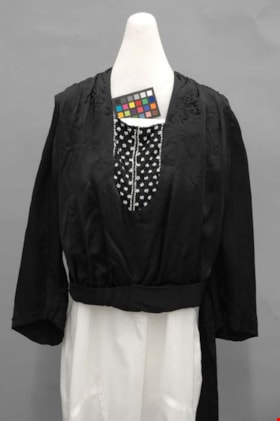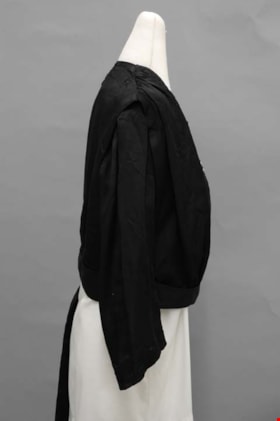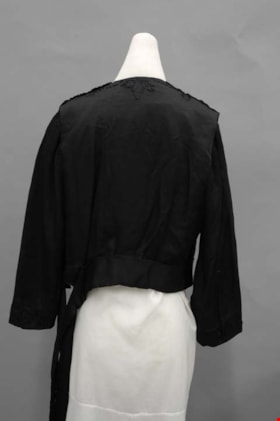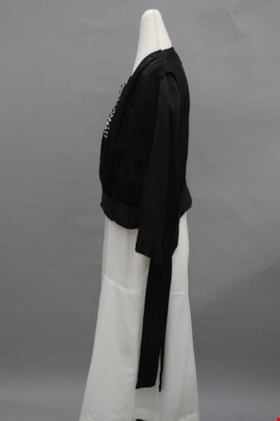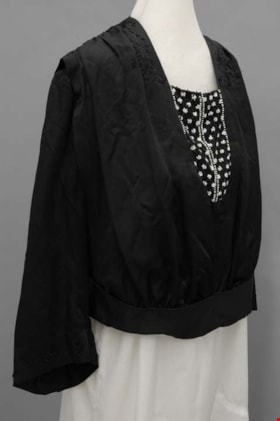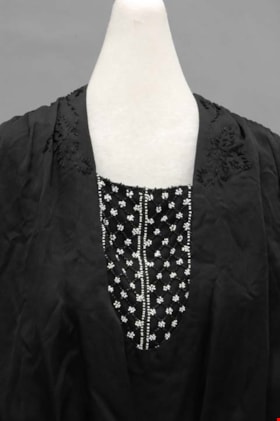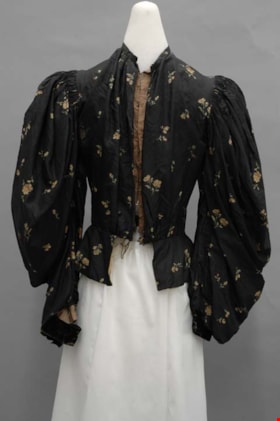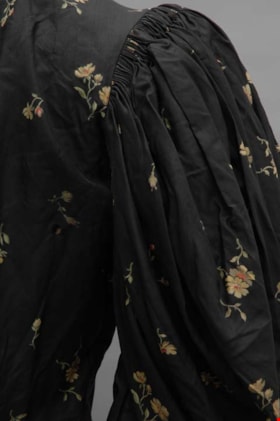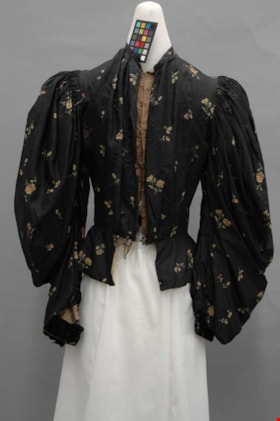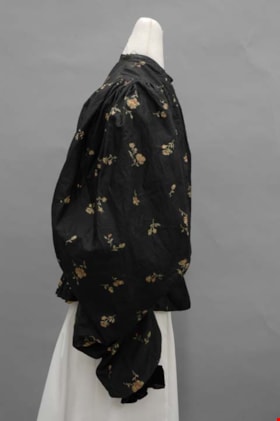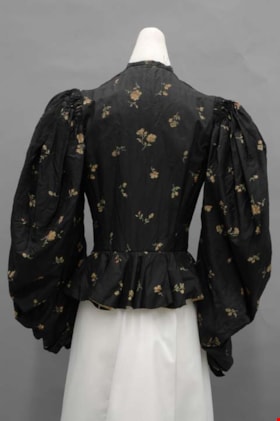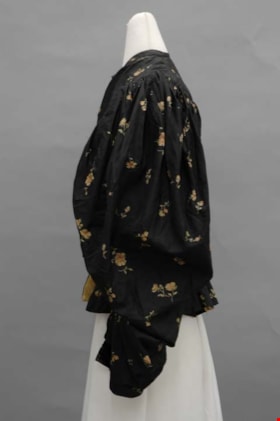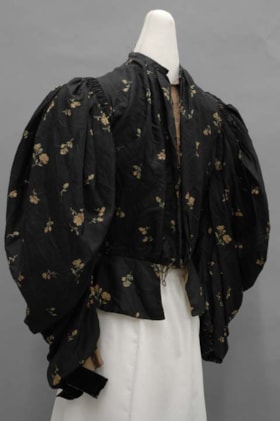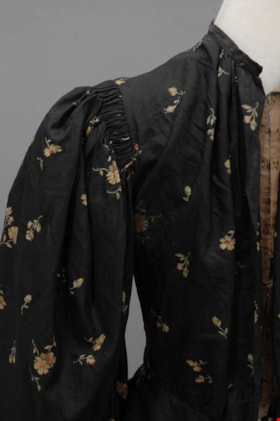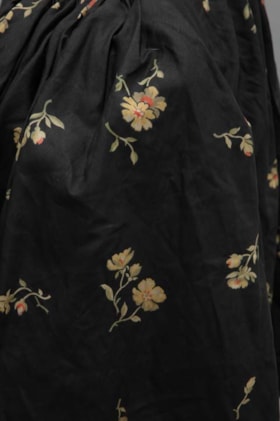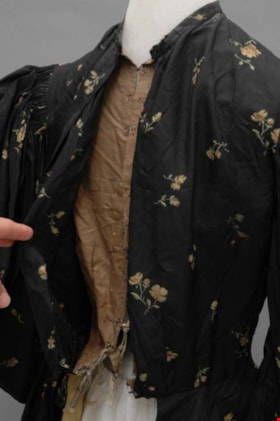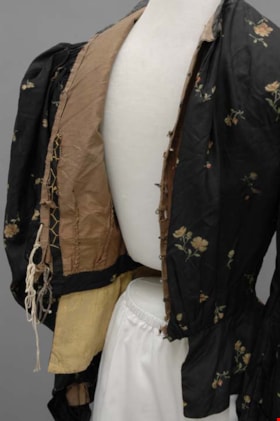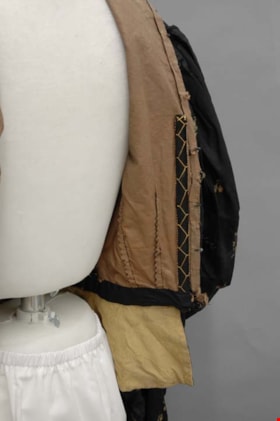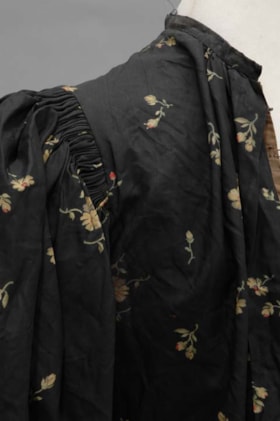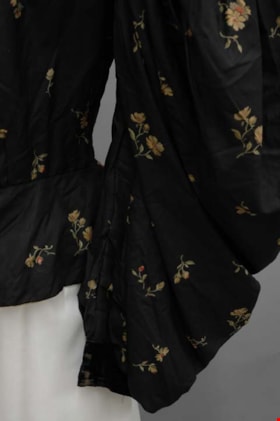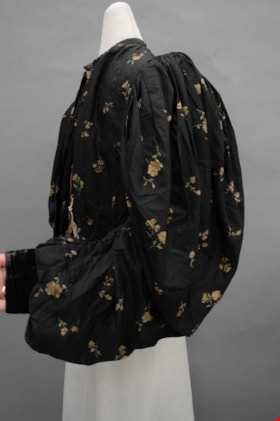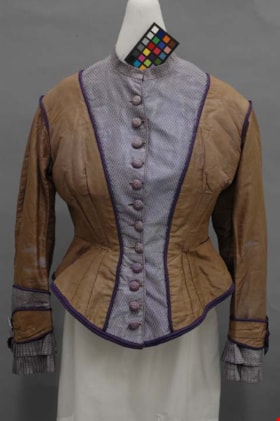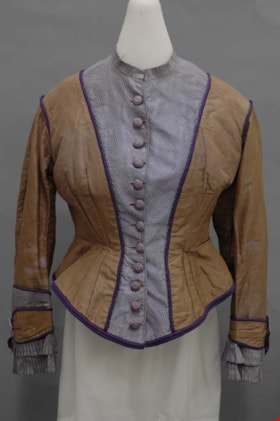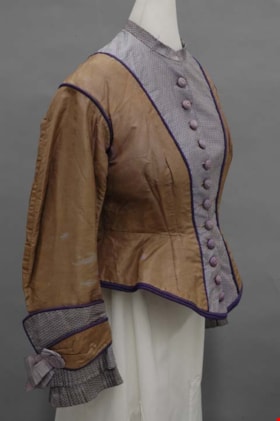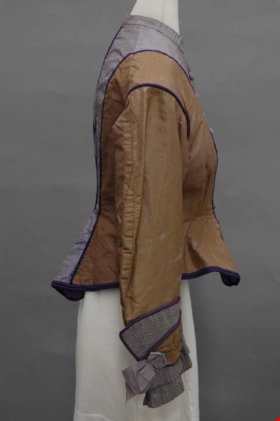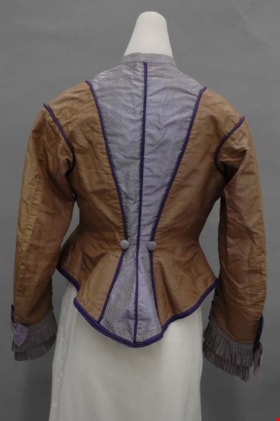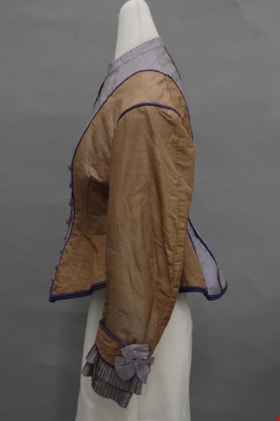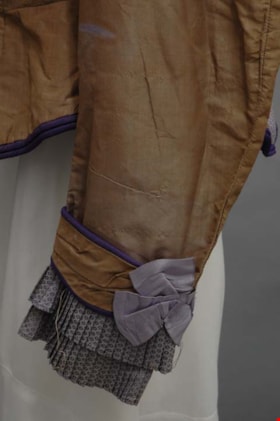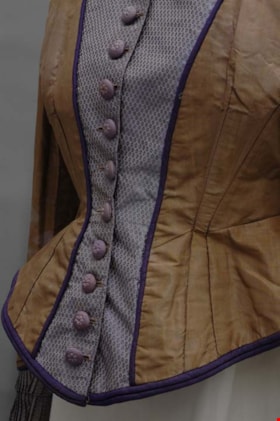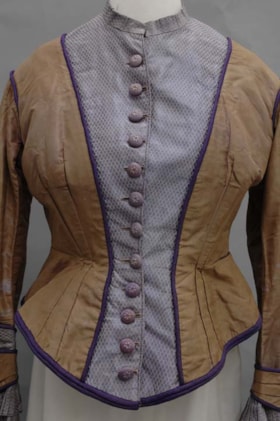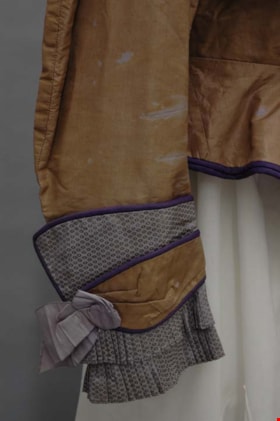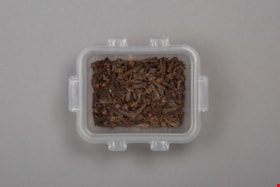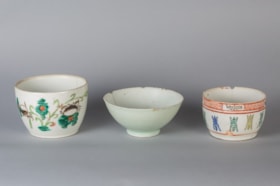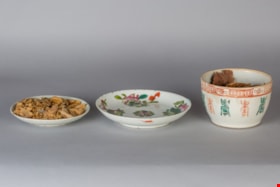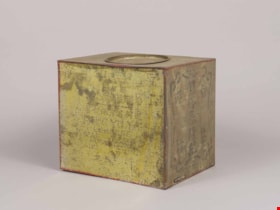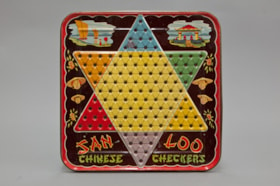Narrow Results By
Subject
- Agriculture - Fruit and Berries 1
- Clothing 10
- Clothing - Costumes 9
- Clothing - Headwear 1
- Communication Artifacts 1
- Container - Box 1
- Documentary Artifacts 3
- Documentary Artifacts - Booklets 1
- Documentary Artifacts - Forms 1
- Documentary Artifacts - Labels 2
- Documentary Artifacts - Letters and Envelopes 1
- Documentary Artifacts - Magazines 1
side dish
https://search.heritageburnaby.ca/link/museumartifact84209
- Repository
- Burnaby Village Museum
- Accession Code
- BV014.16.48
- Description
- The set is made by "Johnson Bros / England". The company logo features an angular crown. The decoration is a flower motif with a blue stem of red berries and flowers with green leaves in the centre of some of the dishes. There is a band of silver pattern with blue highlights and fruits in angular cartouches around the outside edges of the dishes. The side dish is 2.2 cm deep and 13.2 cm diameter at the rim. The band decoration is around the rim of the dish with the stem design in the centre of the dish.
- Object History
- The china was acquired by Charlotte Latham (possibly) in England. The china was used in Burnaby since at least the 1920's since that's when her and her husband settled in Burnaby. The china was gifted to me (Ivaz) by Charlotte's daughter Frances, a Burnaby-born resident her entire life. Frances passed away in 1998.
- Category
- 04.Tools & Equipment for Materials
- Classification
- Food Service T&E - - Eating Vessels
- Object Term
- Dish, Eating
- Maker
- Johnson Bros.
- Country Made
- England
- Subjects
- Food Service Tools and Equipment
Images
soup bowl
https://search.heritageburnaby.ca/link/museumartifact84197
- Repository
- Burnaby Village Museum
- Accession Code
- BV014.16.36
- Description
- The set is made by "Johnson Bros / England". The company logo features an angular crown. The decoration is a flower motif with a blue stem of red berries and flowers with green leaves in the centre of some of the dishes. There is a band of silver pattern with blue highlights and fruits in angular cartouches around the outside edges of the dishes. The soup bowl is 3.3 cm deep and 19.2 cm diameter at the rim. The band decoration is around the rim of the bowl with the stem design in the centre of the bowl.
- Object History
- The china was acquired by Charlotte Latham (possibly) in England. The china was used in Burnaby since at least the 1920's since that's when her and her husband settled in Burnaby. The china was gifted to me (Ivaz) by Charlotte's daughter Frances, a Burnaby-born resident her entire life. Frances passed away in 1998.
- Category
- 04.Tools & Equipment for Materials
- Classification
- Food Service T&E - - Eating Vessels
- Object Term
- Dish, Eating
- Maker
- Johnson Bros.
- Country Made
- England
- Subjects
- Food Service Tools and Equipment
Images
spittoon
https://search.heritageburnaby.ca/link/museumartifact23694
- Repository
- Burnaby Village Museum
- Accession Code
- HV975.5.34
- Description
- Spittoon or cuspidor. Blue enamel with white interior. Enamel is worn around the top opening.
- Object History
- This item originates from the Chinese Herbalist Store "Way Sang Yuen Wat Kee & Co.", Victoria B.C. which is now housed at Burnaby Village Museum. After China became a Communist state in 1949, the spittoon became much more prevalent: spittoons were placed at every conceivable public place, and were commonplace in homes as well. The mass introduction of spittoons was no doubt a public hygiene initiative, motivated by a desire to curtail the once common Chinese practice of spitting onto the floor. The spittoons used in China were typically made of white porcelain, sometimes with traditional Chinese art painted onto the exterior. The fact that there was a spittoon as part of the Way Sang Yuen Wat Kee & Co. Herbalist shop when they closed in the 1970s, may reflect that the practice of the people in 1970s Victoria was similar to those in China.
- Classification
- Chemical T&E
- Measurements
- 15 cm height x 18 cm width x 18 cm length
Images
teacup
https://search.heritageburnaby.ca/link/museumartifact84232
- Repository
- Burnaby Village Museum
- Accession Code
- BV014.16.71
- Description
- The set is made by "Johnson Bros / England". The company logo features an angular crown. The decoration is a flower motif with a blue stem of red berries and flowers with green leaves in the centre of some of the dishes. There is a band of silver pattern with blue highlights and fruits in angular cartouches around the outside edges of the dishes. The teacup is 9.5 cm diameter at the rim. The teacup has the band decoration at the inside rim with a gold line on the outside of the cup and on the attached handle.
- Object History
- The china was acquired by Charlotte Latham (possibly) in England. The china was used in Burnaby since at least the 1920's since that's when her and her husband settled in Burnaby. The china was gifted to me (Ivaz) by Charlotte's daughter Frances, a Burnaby-born resident her entire life. Frances passed away in 1998.
- Category
- 04.Tools & Equipment for Materials
- Classification
- Food Service T&E - - Eating Vessels
- Object Term
- Dish, Eating
- Maker
- Johnson Bros.
- Country Made
- England
- Subjects
- Food Service Tools and Equipment
Images
dress
https://search.heritageburnaby.ca/link/museumartifact46565
- Repository
- Burnaby Village Museum
- Accession Code
- BV004.21.8
- Description
- Dress, c.1910-1913. Cotton lawn print in floral and checkered, with chiffon yoke, lace, and mauve satin silk waistband. Long tiered skirt, long sleeves, round neckline. The cotton lawn fabric has a white background with vertical stripes of black and white checkers; purple flowers with green stems intertwine around the vertical checkers. The neckline rounds into a slight V shape with a yoke of ivory chiffon on top of lace, which extends to the waistband. On the front and back right and left side of the bodice, there is a tab extending over the waistband from the bodice fabric, edged in lace. The bottom of the bodice is gathered to add some volume. The bodice is also open around the shoulders, edged with lace. There is a section of the main fabric underneath that connects to the lining. The sleeves are full length, with some volume. The cuff begins halfway down the forearm with a gathered lace ruffle. The cuff section is narrower, and ends with three snaps at the wrist and another lace ruffle. At the waist, there is a gathered mauve satin silk waistband, tacked on to the dress. The skirt is attached underneath in two tiers. The overskirt, attached to the bodice, has two somewhat flared gores and one godet on the right side seam from just above the knee to the calf. It also ends at the calf, and just above the hem there is a tiny band of drawn thread work embroidery. The bottom tier is attached to the skirt lining under the top hem; it is made up of four gores, all gathered. The lining to the dress is done in ivory china silk, and it extends into the sleeves. In the bodice lining, there are four bones to hold its shape: on in the centre front and back, and one on each side. There are six panels in the back and four in the front, all finished with flat felled seams. The centre front closes with hook and eyes, and the waistband is secured on top with snaps and a hook and eye; the left bodice tab is secured to the waistband with two snaps. The skirt lining is also china silk, closing down the left side front with snaps. The skirt also has a left side opening that closes with snaps. In each underarm there is a dress shield to protect the dress from perspiration. They each read: "Style 100 Trade Mark OMO. E. Y. 2. Odorless. No Rubber. Soak in cold soap suds, using good soap, scrub with a stiff brush, and rinse in clear cold water, shape carefully while wet, and dry thoroughly. Do not iron."
- Object History
- Object was inherited by the donor ca. 1974. She was given it by her mother, who had inherited it from her own mother, Elizabeth (Babb) Heaney.
- Subjects
- Clothing
- Clothing - Costumes
- Historic Neighbourhood
- Central Park (Historic Neighbourhood)
- Planning Study Area
- Maywood Area
Images
magazine
https://search.heritageburnaby.ca/link/museumartifact90893
- Repository
- Burnaby Village Museum
- Accession Code
- BV019.6.30
- Description
- magazine; quarterly publication in English aimed at providing a forum for information exchange in China and Hong Kong trading; glossy cover; 32 p., black text and photographs on newsprint; bifold with two staples; printed by Food Hing Offset Printing Company Limited; front cover reads: "Business Pleasure" / "Special Issue / 1978 Canton Spring Fair"; photograph on front of small ceramic bowl filled with coins and red carnation standing in centre, bowl is seated on a pedestal, two small carved lion sculptures are seated on either side; bottom of front cover includes an ad for "Seiko" watches; back cover includes ad for "Bulova" watches.
- Object History
- Publication "Business Pleasure", was part of a scrapbook created by Cecil Chue Kan Lee documenting the time he was employed as a Prodcue Buyer for Kelly Douglas and Company Limited and Western Commodities Limited in the 1970s and early 1980s. As a produce buyer for Kelly Douglas, Cecil Lee worked closely with local farmers along Marine Drive and in the Fraser Valley. The Burnaby company was one of the largest food distributors in Canada. In the mid-1970s, Lee was asked to oversee the import of Chinese mandarin oranges into Canada. Until that time, mandarin oranges had come from Japan and were sold in the winter, especially at Christmas. When the Japanese market could no longer keep up with demand, Kelly Douglas looked to China. The company relied on Lee’s cultural knowledge to build this very profitable part of their business.
- Reference
- The first few pages of articles within the publication are available for viewing on Heritage Village. Contact Burnaby Village Museum to view entire published content.
- For other records in this collection see: Business records series of Julie Lee and Cecil Lee family fonds
- Category
- 08. Communication Artifacts
- Classification
- Documentary Artifacts - - Other Documents
- Object Term
- Serial
- Country Made
- Hong Kong
- Title
- Business Pleasure
- Publication Date
- 1978
- Subjects
- Documentary Artifacts - Magazines
Images
Documents
samovar
https://search.heritageburnaby.ca/link/museumartifact23354
- Repository
- Burnaby Village Museum
- Accession Code
- HV976.225.2
- Description
- Metal Chinese tea samovar consisting of base, reservoir with tap, and lid; 3 Chinese characters placed vertically on reservoir; metal handles on base and on side of reservoir.
- Object History
- Samovar from the Kwong Chai Tong Herbalist shop, located at 122 East Pender Street in Vancouver's Chinatown. The business was founded in ca. 1915 by Lim Butt. The business was later ran by his son, Lim Bong. The samovar was situated on the counter of the shop, filled with an herbal brew which customers could pour off and drink for a small sum of money. The top portion is the resevoir for the Herbal tea. The lower portion is where the fire was in order to keep the tea warm. Vessel was used to store herbal tea which was offered to visitors for maintaining the balance of their body. Shen Nong is a deity in Chinese religion, a mythical sage ruler of prehistoric China; he has been thought to have taught the ancient Chinese not only their practices of agriculture, but also use of herbal drugs. “Shennong” can also be taken to refer to his people, the Shennong-shi (Shennong Clan). According to legend, tea was first discovered by Shennong over two thousand years ago. It is written in Classic of Tea that, "The tea drinking tradition began with Shen Nong and actively developed by the Duke of Zhou." Tea was used in ancient China. It is said that Shen Nong, the God of Medicine who tasted all herbs was poisoned by 72 different plants everyday. He relied on tea to neutralise the toxins. As for how he discovered this plant which can treat all sorts of ailments, there are many different versions.
- Classification
- Chemical T&E
- Marks/Labels
- Label contains 3 Chinese characters that are translate to: Shen Nong Cha (the God of Medicine’s tea). Product is a medicinal tea brand name which uses more than 10 types of herbs to make the tea. Consumed to relieve symptoms of a cold. Often consumed during the summer months to help someone stay cool.
- Measurements
- 60 cm height x 30 cm diameter
Images
teacup and saucer
https://search.heritageburnaby.ca/link/museumartifact87482
- Repository
- Burnaby Village Museum
- Accession Code
- BV015.35.92
- Description
- teacup and saucer; white bone china with swirl pattern; gold and navy blue scattered trefoil pattern on a light blue background; "AYNSLEY / ENGLAND / BONE CHINA / 2B" on bottom in green; "2495 F" in gold on bottom of teacup; "2495" in gold on bottom of saucer.
- Object History
- Teacups and saucers previously owned by May Aikenhead (Elizabeth May). May was a member of the Burnaby Royal Trefoil Guild for many years.
- Category
- 04.Tools & Equipment for Materials
- Classification
- Food Service T&E - - Drinking Vessels
- Object Term
- Teacup
- Subjects
- Organizations - Girls' Societies and Clubs
- Organizations - Women's Societies and Clubs
- Food Service Tools and Equipment
Images
wedding dress
https://search.heritageburnaby.ca/link/museumartifact4388
- Repository
- Burnaby Village Museum
- Accession Code
- BV988.48.63
- Description
- Wedding dress, c.1900-1906. Cream lace net lined with white china silk. High collar, pouter pigeon front, puffed sleeves. Comes with a long sash and matching skirt. The collar is made of several bands of lace. The bodice is also lace, with embroidery. On the front there is a pin tucked yoke, and bordering this on the front and back are circles of lace with line embroidery inside. Below this there are more pin tucks and bands of lace. The front puffs out creating a pouter pigeon bodice, and there is a gathered flounce below the waistline. It closes with hooks and eyes at centre back. The sash, a long yellowish-cream piece of silk fabric, would go overtop of the waist. The sleeves are gathered at the cap and again at the cuff. There are bands of lace at the lower forearm, and they end with lace flounce cuffs of the same embroidered circles seen on the bodice. The skirt has a lace top layer and a white china silk lining that is attached at the small waistband. There are tiny pin tucks in the lace layer at the waistband. Halfway down, there is a band of embroidered circles, the same as those on the bodice. They are separated by two bands of lace. There are two more of the same bands of lace near the hem. The net layer has three gores, and the lining has five. There are also two ruffles at the lining hem.
- Object History
- Donor acquired object in 1951 from the estate of her mother-in-law, Flora Isabell (McArthur) McOuat.
- Subjects
- Clothing
- Clothing - Costumes
Images
wedding dress
https://search.heritageburnaby.ca/link/museumartifact11635
- Repository
- Burnaby Village Museum
- Accession Code
- BV985.3523.1
- Description
- wedding dress, c.1902-1908. White china silk. Pouter pigeon bodice with half length sleeves and cumberbund. Skirt is shirred at waist and flares out at lower half. This Edwardian wedding dress is made almost entirely of china silk. Usually a lining fabric, the Edwardians often used it for special occasions such as weddings to achieve a floating, puffed up silhouette without any bulk at the waist. The bodice has three layers of ruffles at the high round neckline. The bodice front has two layers to hide its hook and eye closures. The back of the bodice has two panels four pin tucks for shaping. At the shoulders, there are rows of shirring that continue into the sleeve. The sleeves are gathered again into a cuff at their ends. The cumberbund is shirred at each end, as well as in the centre with three rows of shirring. There are three stays at the centre and one at each end; it closes with hooks and eyes which are covered by bows. The skirt has multiple rows of shirring at the waist. It has three gores, including one at the centre front that extends from the waistband without any shirring. There are two godets at the back seam and one at each of the side seams that begin at hip level and continue until about calf level. Then there is a new band of silk shirred onto the skirt, with three horizontal tucks at the bottom; the last tuck forms the hem. It is self lined under the bottom shirred section, with an un-gathered lining.
- Subjects
- Clothing
- Clothing - Costumes
Images
baseball cap
https://search.heritageburnaby.ca/link/museumartifact79037
- Repository
- Burnaby Village Museum
- Accession Code
- BV007.3.2
- Description
- Give-away baseball cap from the Bridge Film Studio in Burnaby. The cap is black with red trim, "knp" makers logo. Made in China, 100% polyester.
- Object History
- Obtained from the Bridge Studio Burnaby circa 2006. The Bridge Studios was built in 1987 on 15 acres of land that was formerly part of the Dominion Bridge bridge-building plant. From 1930 until the mid 1970s, Dominion Bridge constructed steel structures ranging from portions of the Golden Gate and Lions Gate Bridges to holding tanks for pulp mills. Several of the Dominion Bridge buildings were re-used by the studio, including the Cafeteria Building, the Boiler House, and the Compressor Building. In the mid-1970s filming began on a temporary basis in unused portions of the plant. In 1987, after lobby efforts by local film industry unions, guilds, and suppliers, the Government of British Columbia agreed to invest in renovating the site to create a permanent studio facility in order to ensure that BC had a stable base of operations for film production. The Bridge Studios, the first dedicated studio facility in Vancouver, opened for business in 1987 with television series "MacGyver" and the feature film "Stakeout" among the first productions to have used the facility.
- Subjects
- Clothing
- Clothing - Headwear
- Names
- Bridge Studios
Images
bench
https://search.heritageburnaby.ca/link/museumartifact23363
- Repository
- Burnaby Village Museum
- Accession Code
- HV976.225.11
- Description
- Herb planing bench. Painted pink
- Object History
- Planing bench made by Lim Bong, proprietor of the Kwong Chai Tong herbalist shop at 122 East Pender Street in Vancouver's Chinatown. According to donor, "it is typical of those used in China for many generations".
- Subjects
- Persons - Chinese Canadians
Images
bodice
https://search.heritageburnaby.ca/link/museumartifact19455
- Repository
- Burnaby Village Museum
- Accession Code
- HV977.37.107
- Description
- Bodice, c.1915. Black satin silk. Straight cut, gathered. Three quarter length sleeves, square neck, black embroidery, black and white glass beads, sash at waist. The bodice is cut straight, falling just past the natural waist, with volume added through pleats and gathers. At each front shoulder there are gathers, as well as along the bottom front. At the bottom back, there are pleats. The neckline is trimmed with embroidery in a leaf pattern, done in black floss. At the centre front it dips down in a square neckline, with a beaded panel starting at the bottom of the square. It is made up of back and white glass beads in a diamond pattern on a black net background. The panel is in a shield shape. The sleeves are loose fitting, with black floss embroidery around the cuffs in a looping pattern. At the bottom of the bodice there is a sash that covers the pleats and gathers, and extends on the left side where it may have been tied. The sash also closes with a snap, one on the sash ties and two more at the point where they close on the bodice. There are also snaps on the left shoulder. Inside, there is a black china silk lining that closes at the centre front with hooks and eyes.
- Object History
- From the family home of Thomas Seaborn McNair and Mary Vida (nee McMillan) McNair who lived on West 33rd Avenue in Vancouver. Thomas McNair ran Edwards, McNair and Russell, an established estate agent business.
- Subjects
- Clothing
- Clothing - Costumes
Images
bodice
https://search.heritageburnaby.ca/link/museumartifact21345
- Repository
- Burnaby Village Museum
- Accession Code
- HV976.53.5
- Description
- Bodice, c.1895. Black patterned china silk with green, pink, and gold flowers. Huge leg o' mutton sleeves gather into small black velvet cuffs. Slightly puffed front, peplum. At the small round neckline, there is a small half inch stand collar. The centre front of the bodice is gathered at the neckline and at the waist. Beneath the waist, there is a peplum with most of its flare in the back. The rest of the bodice is unadorned, as the sleeves are really the main focus. The sleeves are cartridge pleated around the top of the armscye. The lightweight fabric and internal supports make each shoulder puff out to roughly the size of a watermelon. They taper slightly to the cuff (where they are gathered), but most of the volume remains for the whole sleeve. The black velvet cuffs have a flower on the outside, but no opening. Inside, the bodice is lined with brown cotton, and nine bones. The peplum is lined with gold a silk floral brocade. The bodice has hook and eye closures up the centre front.
- Object History
- Belonged to donor's mother in law from South Dakota.
- Subjects
- Clothing
- Clothing - Costumes
Images
bodice
https://search.heritageburnaby.ca/link/museumartifact29996
- Repository
- Burnaby Village Museum
- Accession Code
- HV973.73.155
- Description
- Bodice, c.1870-1875. Olive green silk shot with purple, with purple brocade, ribbon, and cotton twill piping. Buttons down centre front, high neck, long sleeves, cuirass design. The stand collar is fairly small, with a close neckline. It is made of a mauve silk brocade with a pattern of tiny purple ovals. There is a panel of this fabric that goes down the centre front and centre back from the shoulders to the hem, separated from the main fabric by purple twill piping. At the centre front, the bodice also closes from top to bottom with twelve buttons covered in mauve fabric with a brocade flower and a hook and eye at the collar. At the centre back there is another line of purple piping, and there is a self fabric covered button on each outside line of piping at the waist level. The rest of the front and back bodice is made of the olive and purple shot silk, with two darts at each side front. The armscyes are sewn with purple piping, and the sleeves are made in the olive and purple shot silk. At the cuffs, there is a band edged in purple piping and trimmed with a mauve ribbon bow. Beneath this there are two tiers of pleated ruffle in the mauve brocade. At the hem of the bodice, there is a double row of purple piping. The bodice is lined in brown linen. It has short bones in each front dart, and one in each side seam. The section below the waist is lined in purple china silk.
- Subjects
- Clothing
- Clothing - Costumes
Images
botanical specimen
https://search.heritageburnaby.ca/link/museumartifact88680
- Repository
- Burnaby Village Museum
- Accession Code
- BV017.7.52
- Description
- English Name: Clove Chinese Pinyin Name: Dingxiang (DingXiang) Physical Description: small dried flower buds, dark brown and twiglike with rounded heads held by 4 sepals; lower portions are slightly tapered and rough Production Regions: Primarily produced in Zanzibar Island of Tanzania, as well as Malaysia and Indonesia. In China, it has been introduced into cultivation in the provinces of Hainan and Guangdong. Functions: Warms stomach, warms kidney. Apply to cold stomach and swelling pain, hiccup, vomiting and diarrhea, impediment, colic, ozostomia, toothache.
- Object History
- Collection of original raw contents of the Chinese Herbalist Shop, Way Sang Yuen Wat Kee, Victoria BC, as purchased from Rodney Pain in 1974.
- Reference
- Chinese Medicinal Material Images Database, School of Chinese Medicine, Hong Kong Baptist University. URL: http://libproject.hkbu.edu.hk/was40/detail?channelid=47953&lang=eng&searchword=pid=B00299 ; Compendium of Materia Medica (Bencao Gangmu), 2003;
Images
bowl
https://search.heritageburnaby.ca/link/museumartifact23966
- Repository
- Burnaby Village Museum
- Accession Code
- HV975.5.326
- Description
- White china bowl with red rim on top and bottom of outside; blue, green, and gold characters painted on outside of bowl between red rims. Artifact is third from left in photograph.
- Object History
- This item originates from the Chinese Herbalist Store “Way Sang Yuen Wat Kee & Co.”, Victoria B.C.
- Classification
- Chemical T&E
- Measurements
- 6 cm height x 8 cm diameter
Images
bowl
https://search.heritageburnaby.ca/link/museumartifact24259
- Repository
- Burnaby Village Museum
- Accession Code
- HV975.5.754
- Description
- Bowl, china, with green and red geometric pattern Artifact is third from the left in photograph.
- Object History
- This item originates from the Chinese Herbalist Store "Way Sang Yuen Wat Kee & Co.", Victoria B.C.
- Category
- 04.Tools & Equipment for Materials
- Classification
- Food Processing & Preparation T&E
- Measurements
- 2.5cm height x 8.5cm wide
- Subjects
- Food Processing Tools and Equipment
Images
box
https://search.heritageburnaby.ca/link/museumartifact24800
- Repository
- Burnaby Village Museum
- Accession Code
- HV975.5.1298
- Description
- Tin; "Pang Yu Tai Lungkee gun Jam Tea Hong Kong and China"; with lid
- Object History
- Contents of Chinese Herbalist Store "Way Sang Yuen Wat Kee & Co.", Victoria B.C.
Images
chinese checkers game
https://search.heritageburnaby.ca/link/museumartifact82346
- Repository
- Burnaby Village Museum
- Accession Code
- BV012.14.91
- Description
- "SAN LOO / CHINESE CHECKERS" metal board game, colourful star with divots and scenes from china and stereotypical chinese characters. Measures 35 cm square.
- Object History
- Used in the Yanko family home. Annie D. Basiuk (later Yanko) was born on February 25, 1902 in Sheho, Saskatchewan (formerly Sheho, North West Territories). Daniel "Dan" Yanko was born in Kobilnicha, Ukraine in 1887 and immigrated to Canada in May or June of 1905. Daniel Yanko married Annie D. Basiuk and had thirteen children together. Their son, John Ivan Yanko was born on the family farm, near Kelliher, Saskatchewan, on June 27, 1923. In grade six, John was pulled out of school to help support the family. Eugenia “Jenny” Haresomovych (later Carman) was born August 8, 1904 in Galecia, Austria. She came to Canada in 1928, when her parents sent her to live with the Austrian consular in Halifax. A year later, she was in The Pas with Albert Edward Carman, with whom she would have three children. Their daughter, Leida Doria "Lillian Doris" Carman was born in The Pas, Manitoba March 24, 1929. Eugenia “Jenny” (Haresomovych) Carman later re-married Joseph Nagy who was born in Hungary in October 3, 1900. Jenny, Joseph and the children moved to Nelson, British Columbia, where Joseph worked for the Canadian Pacific Railway. At the age of twenty, John Yanko met his future wife Lillian Doris Carman while visiting relatives in Burnaby. Lillian received a rail pass because of her dad’s employment with the CPR and at fourteen had gone to visit her Godmother in Burnaby. John Ivan Yanko and Leida Doria "Lillian Doris" Carman were married October 16, 1948 in Nelson, British Columbia and moved into the basement of John’s sister’s house on Union Street. Lillian began working at the downtown Woodward’s store as a cashier in 1948. In 1950, the young couple bought property at 7385 (later renumbered 7391) Broadway in Burnaby and began constructing a house as they could afford it. Knowing she’d be let go if she was pregnant, when Lillian was expecting her first child, Jenny sewed her several versions of the same outfit; they all used the same material, but each was a little bit larger than the last to accommodate her expanding girth. Rhonda, born in 1953 and Charmaine, born in 1955, grew up in the Broadway home. They attended school at Sperling Elementary, and later at Burnaby North high school. Lillian left her job to be a stay-at-home mom when Rhonda was born, but that changed in 1963 when John and Charmaine were in a car accident that left John temporarily unable to work. Joseph Nagy died April 20, 1962; his wife Eugenia “Jenny” (Haresomovych) (Carman) Nagy passed away August 14, 1985. Daniel "Dan" Yanko died in 1976; his wife Annie D. (Basiuk) Yanko died in 1997. John Yanko later returned to work, establishing his own tile setting business and working until age eighty-two. John and Lillian lived out the rest of their married lives on the Broadway property. John Ivan Yanko passed away in 2010; his wife Leida Doria "Lillian Doris" Carman (Carman) Yanko passed away in 2011.
- Subjects
- Games
- Names
- Yanko Family
